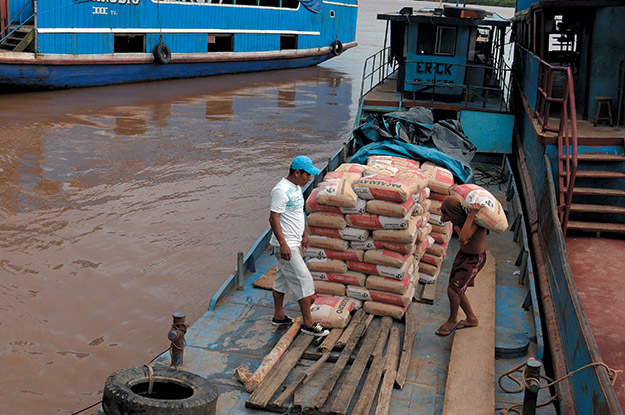In 2011, shortly after he took office, Peru’s President Ollanta Humala signed a law guaranteeing the right to prior consultation for indigenous communities that could be affected by development projects on or near their land. The legislation, known as consulta previa in Spanish and based on the International Labor Organization’s Convention 169, was enacted in response to protests that erupted in 2009 over fears that indigenous lands would be expropriated by logging and oil drilling interests. The protests left more than 30 people dead.
Now, the first implementation of the prior consultation law for a major infrastructure project in Peru has been completed, though progress has come in fits and starts.
The project in question is the Hidrovía Amazónica, a $70 million plan to create a year-round shipping route from the mouth of the Amazon River in Brazil to Peru’s Pacific ports. The project, which would affect Peru’s Amazon, Ucayali, Marañón and Huallaga Rivers, was initially suspended in February 2015 after one of the indigenous groups in the area filed a complaint with the Constitutional Court in Nauta, in northeastern Peru, arguing that the government was required to consult indigenous communities along the rivers before proceeding with the plan.
After the first round of consultation discussions, most of the organizations involved wanted the process to return to the information stage, and asked for more complete details about environmental, social and cultural impacts of the project, according to Wendy Pineda of the Inter-Ethnic Association for Development of the Peruvian Amazon, the largest umbrella group of Amazonian indigenous organizations. Others insisted that titling of communities be completed before the project continues, to ensure that easements would not affect territorial rights.
“The river isn’t just a highway,” said Alfonso López, president of the San Pablo de Tipishca Cocama Association for Development and Conservation, the largest organization of Kukama Kukamiria people in the lower Marañón Valley, which filed the complaint in February.
“We need a technical explanation and justification of what (the project) will mean for biodiversity and for the livelihoods of the communities along the river,” López said at the time. “They want to change the course of the river, and if they do that, the communities will suffer the consequences.”
One of the indigenous groups’ concerns is the possibility that dredging will eliminate the sandy beaches where they plant crops during the dry season, when water levels are low. Some also say that removing submerged tree trunks could disturb the places where they fish.
Moreover, increased river traffic could pose a danger to the canoes used by inhabitants in a region where rivers are the only avenues of transportation. Canoes sometimes capsize in the wake of larger vessels and, according to López, the waves they produce could also threaten homes, especially during the rainy season, when water levels rise to the doorsteps of the stilt-raised wooden houses typical of Amazonian communities. Kukama leaders also note the cultural significance of the waterways. The river is the center of their vision of the cosmos, inhabited by spirits and by the boa snake, which gave birth to the first Kukama person.
Omar Livia, a specialist in the Peruvian Ministry of Culture’s Prior Consultation Office, said the process for the Hidrovía was especially complex. The project spans four rivers in two regions and involves some 350 communities and more than a dozen indigenous groups. At the same time, some scientists say too little is known about sediment flows in the rivers to establish a baseline for measuring future environmental impacts.
Implementation of the prior consultation law has often been problematic in Peru, even for projects of smaller scale and complexity than the Hidrovía. Some indigenous groups object to the fact that the process does not give them veto power over projects that might affect them. There are also questions about which communities qualify as “indigenous.”
But the case of the Hidrovía was particularly fraught. When ministry officials met in March of this year with the groups that would be affected, most knew little about project, indigenous leaders and advisers said.
Even when the consultation process was officially launched in Iquitos in late May, some of the leaders attending the kickoff meeting said they had only recently heard about the plans.
Two rounds of informative meetings and internal evaluations ended September 22 with the signing of agreements on terms of reference for the concession contract and the environmental impact study. The agreements came after a dialogue that ran two days longer than planned. Late on the last day, the indigenous leaders asked for more time to allow them to consult their members, but they signed the agreement after government representatives agreed to set up a task force to address social issues. The government could sign the Hidrovía concession contract in 2016.
Roberto Guimaraes, vice president of the Federation of Native Communities of Ucayali (FECONAU), said his organization continued to oppose the project. “This is a complicated issue for communities to understand,” he said. “The indigenous organizations had legal advice about their rights, but lacked technical or engineering assistance for understanding possible environmental impacts of the project.”
—
Barbara Fraser is a freelance journalist based in Lima, Peru.





